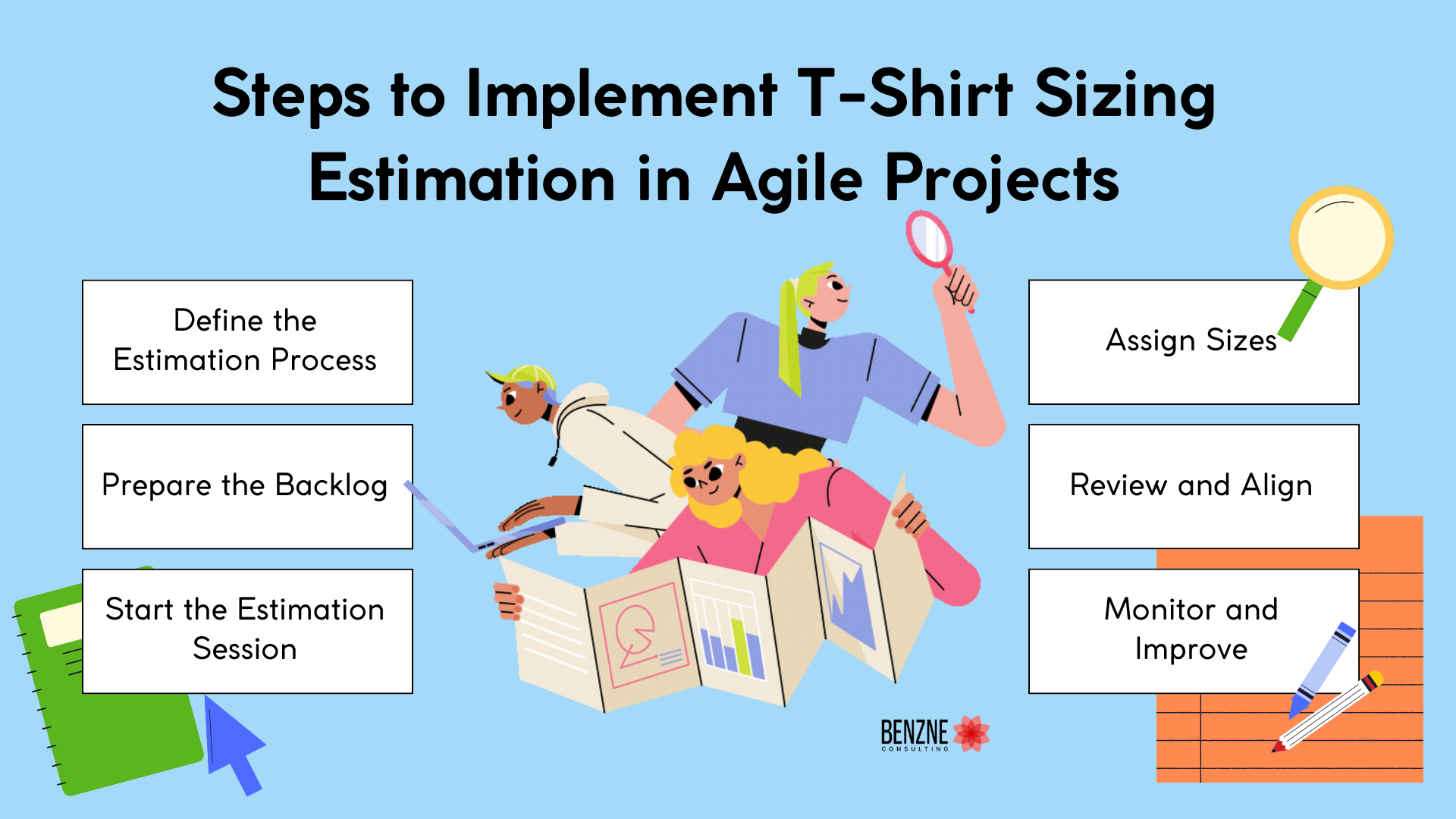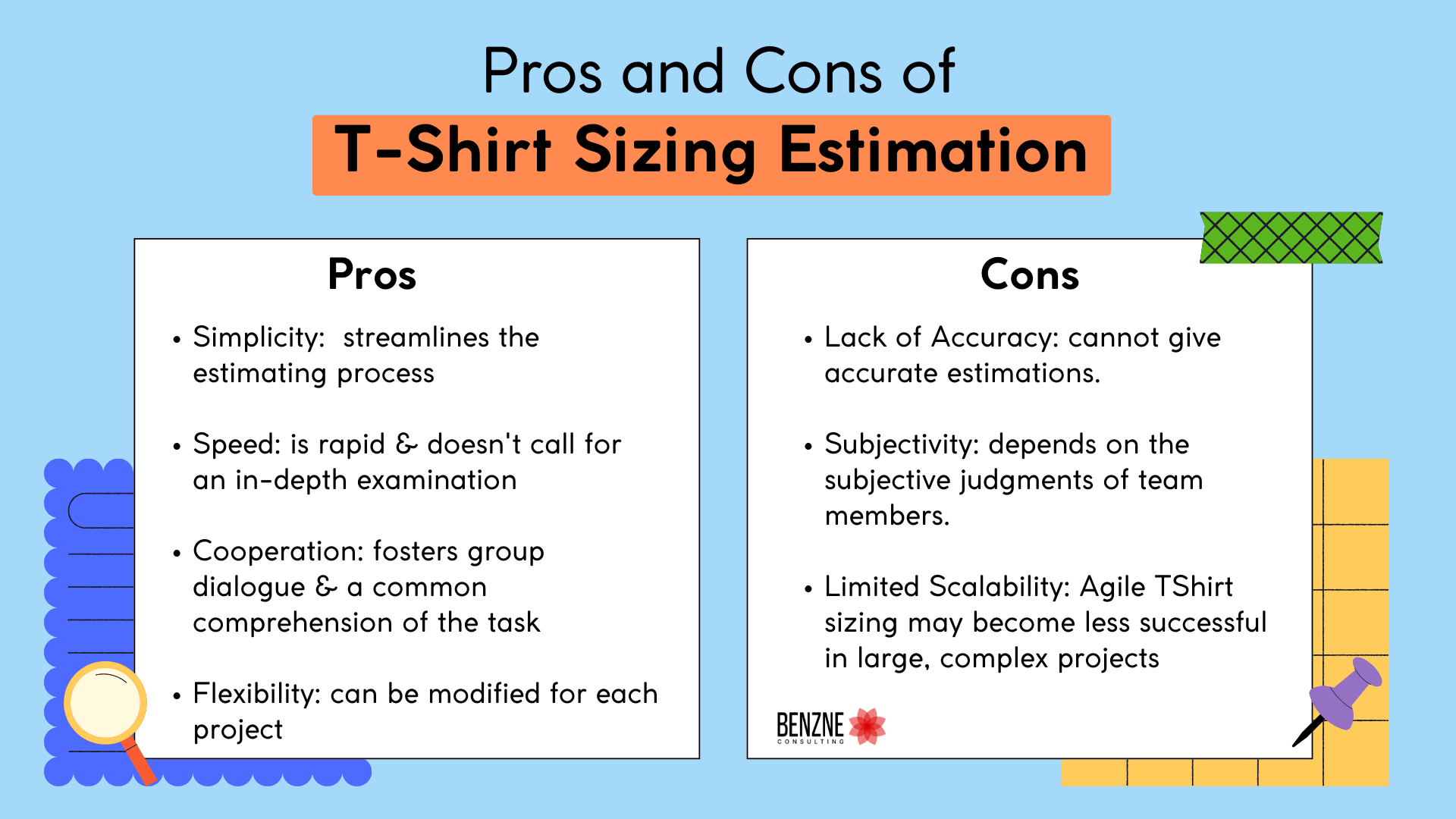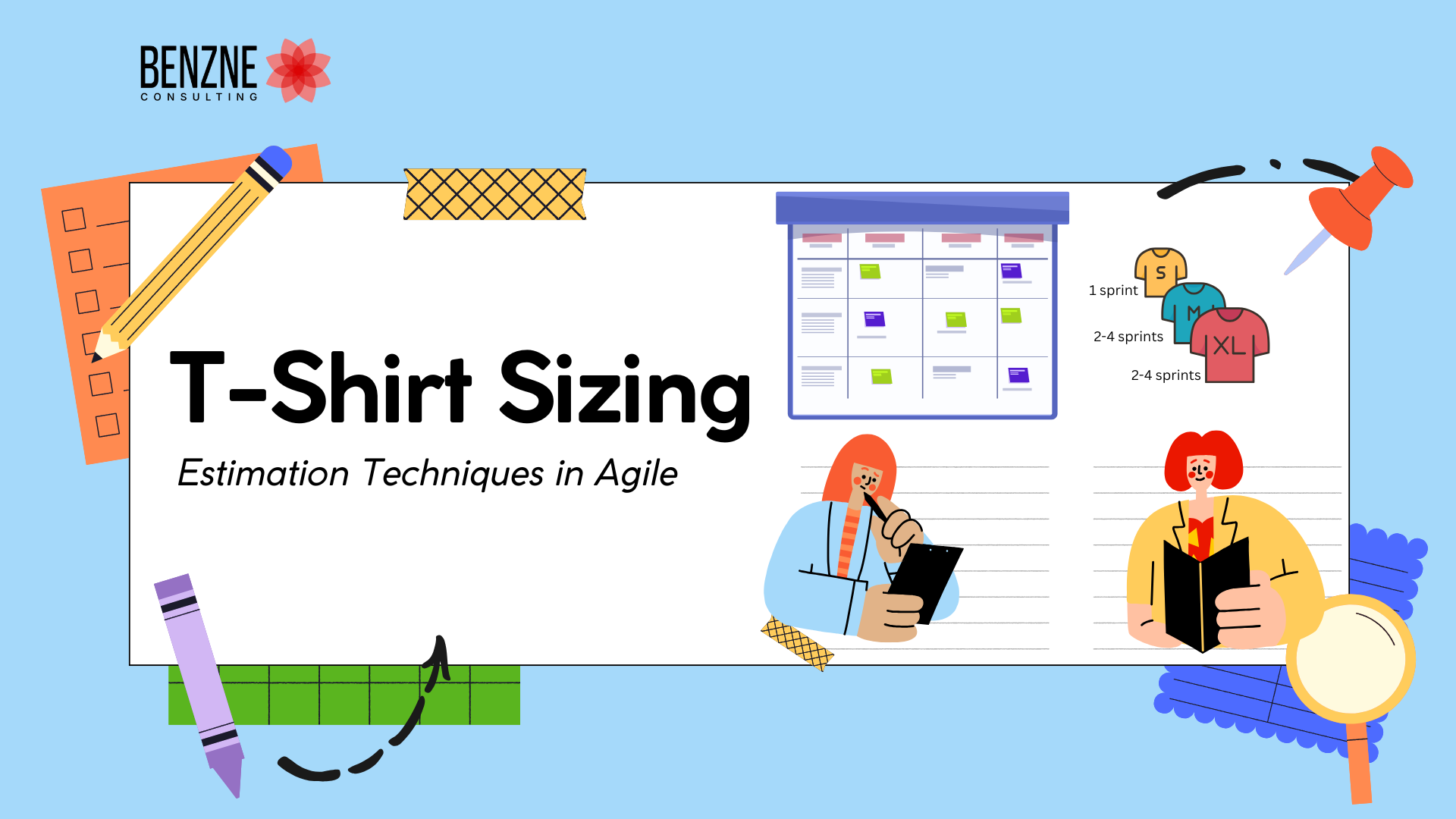What is T-Shirt Sizing Estimation?
Estimating the effort required to finish the tasks and understanding the complexity associated with the tasks is one of the most important cornerstones of Agile ways of working. As a matter of fact, the teams which estimate their work accurately are able to plan their sprints and distribute resources much better, which in turn helps in delivering results on time. However, in situations where precise estimations are difficult to determine or for teams that are unfamiliar with Agile, estimation techniques like hourly estimation or story point estimation can occasionally turn out to be overwhelming.
T shirt sizing estimation is a straightforward yet an efficient method of estimating the work/ backlog which is derived from apparel sizing. In this approach, the teams give estimation as the common T-Shirt sizes, such as XS, S, M, L or XL. Teams can classify the complexity of the task and effort needed to complete them without getting into the complex calculations and coming up with absolute values, instead, they can come up with relative way of estimation where the smallest task with least complexity can be called as XS and other tasks, which are relatively complex and bigger are assigned the bigger sizes like S or M or L. The idea here for the teams is to concentrate on providing value or a ballpark by using Agile TShirt sizing estimates rather than being bogged down in intricate time projections. This T Shirt sizing estimation in turn helps in streamlining the estimation process and getting absolute estimates.
In this blog, we will cover agile sizing techniques and Agile TShirt sizing estimation strategy in detail, including how it works, how to use it, its benefits and drawbacks, its challenges and how it compares to the other Agile estimation techniques drawing from our agile consulting and training services experience.
Why T-Shirt Sizing Estimation is Popular in Agile?
T shirt sizing has become a popular technique for estimation in Agile due to several reasons:
- Easy, quick and effective: The amount of time required to generate estimates is one of the primary obstacles to Agile estimation. Conventional approaches, like story points or hourly estimation, require collaboration with all team members, where the teams then get into conversations, which end up in wastage of time and effort (additional effort if the team later realizes that the estimation was not done accurately). Tasks can be quickly and easily categorized using T Shirt sizing estimations without making things too complicated.
- Relative Estimation: T Shirt sizing estimation is based on relative estimation meaning teams give the estimation of tasks by comparing them to one another rather than attempting to award a precise number of hours or points to each work. Here, the team first identifies one task as the base task which they can provide with the least estimate, say XS. They then compare all the other tasks with this basic task and provide equal or higher estimation based on increased complexity and effort required to complete and deliver it. Agile T-Shirt sizing way of estimation helps in lessening uncertainty, particularly while working on complicated, novel or frequently changing projects.
- Visual and Intuitive: Because T-Shirt size is visible, it is simple and quick for all team members to understand. Even stakeholders who may not be very familiar with Agile ways of working and estimating, may comprehend the estimating process by utilizing well-known words like XS, S, M, L, XL.
- Collaborative: T Shirt sizing estimation promotes collaboration among team members. Teams may use strategies like Planning poker which is commonly used by agile teams to estimate, in which each team member anonymously selects a size depending on how they view the work. If there is a disagreement, the team gets into a deeper conversation to understand the reason for difference, they vote again until all the team members align on the complexity and effort required to complete the job. This promotes pull based work culture indirectly since everyone is aligned with the scope and the effort of the work.
How Does T Shirt Sizing Estimation Work?
Agile T Shirt sizing uses several sizes, usually ranging from Extra Small (XS) to Extra Large (XL), to classify the amount of work needed to do a job or user narrative. These sizes indicate a task’s relative difficulty, magnitude, effort, complexity and time required. But unlike other estimating methods,T-Shirt sizing sizes are usually not associated with particular plot points or time units.
Here’s a basic breakdown of how T Shirt size in Agile works:
- Preparation: All team members should have a comprehensive understanding of the tasks or user stories before the team members start estimating. This guarantees that everyone in the group is aware of the deliverables and scope
- Initial Discussion: Every item in the backlog is discussed by the team. They take into account various elements including risk, complexity, effort and resources required
- Team Estimation: Every team member chooses a T Shirt size that they feel best captures the difficulty of the assignment. To guarantee that everyone’s viewpoint is heard without bias, teams may employ strategies like planning poker or silent voting
- Debrief/Discussion: Upon revealing the estimation, if team members are not on the same page, the team talks about the rationale behind any discrepancies in the sizes selected in order to comprehend various viewpoints. This conversation guarantees that everyone is in agreement with the work and helps to bring the group together
- Assign Size: The group decides on a size for every item after deliberating on it. One of the T-Shirt sizes (XS, S, M, L, or XL) is then assigned to all the tasks in the project/assignment
- Refinement: The group may improve its comprehension of the sizes over time and make the necessary adjustments. As the team learns more about the effort required and complexity associated with each T-Shirt size, they should change the procedure
Steps to Implement T Shirt Sizing Estimation in Agile Projects
To implement T Shirt sizing in an Agile project, one can follow the these steps as guidelines:

- Define the Estimation Process: Ensure that all team members are aware of the T Shirt sizing process, the size range and how each size relates to complexity and effort, this will help the team to estimate faster and accurately. Using examples for various sizes (e.g., XS for simple jobs which require less than 1 week to complete, S for little difficult tasks requiring 2-3 weeks of time to complete M more difficult activities and so on…) may be useful
- Prepare the Backlog: Before the team meets for estimation, the team should make sure that the backlog is ready and all the ideas/ initiatives are divided into features, user stories and tasks that need estimates. Make sure these narratives are precise, well-defined and provide sufficient information to enable precise scaling
- Start the Estimation Session: Once the backlog is ready, the team should call a meeting to discuss the estimations. Scrum master should make sure that everyone on the team is aware of the backlog items by first going over each item in the backlog and its dependency and needs
- Assign Sizes: For every user story, an Agile T Shirt size is chosen by each team member. If the sizes selected differ significantly, the team should get into a discussion and get to a point where every team member agrees with the chosen T-Shirt size
- Review and Align: When the initial T-Shirt size is different and has a huge gap amongst different team members, talk about the differences in the chosen sizes. Upon the discussion, change the sizes to reach an agreement. This makes it more likely that the final estimate will accurately represent the group’s overall comprehension of the task
- Monitor and Improve: The scrum master must compare the actual effort needed to accomplish activities with the accuracy of your T Shirt sizing estimations over time. Make use of this input to enhance the sizing procedure in subsequent sprints
T-Shirt Sizing Estimation Techniques: Best Practices
To make the most of T Shirt sizing estimation, here are some best practices:
- Keep it Simple: Simplicity is the aim of T-Shirt sizing. Steer clear of making the process overly complicated or devoting too much time to any one activity. Limit yourself to a few general size groupings.
- Involve the Whole Team: The estimating process should be open to all people engaged in completing the task, including stakeholders, product owners, developers, architects and testers
- Use Consistent Definitions: Make certain that each team member is aware of the significance of each T Shirt size. To guarantee consistency over several estimations, you may specify each size using samples of previous user stories
- Focus on Relative Size: Relative estimate is the basis for Agile TShirt sizing. Instead of attempting to allocate precise time or effort units, concentrate on how activities relate to one another
- Use Visual Aids: The team can more readily track and compare sizes with the use of visual aids like boards or charts. This is especially helpful for teams that work remotely
Pros and Cons of T-Shirt Sizing Estimation

Pros:
- Simplicity: By employing well-known and easily understood categories,T Shirt size streamlines the estimating process
- Speed: The procedure is perfect for teams that demand prompt response because it is rapid and doesn’t call for in-depth examination
- Cooperation: The method fosters group dialogue and a common comprehension of the task
- Flexibility: Regardless of the domain or level of intricacy, T Shirt size may be modified for each project
Cons:
- Lack of Accuracy: T Shirt size cannot give accurate estimations, which can be problematic for applications requiring specific deadlines or thorough preparation
- Subjectivity: The approach depends on the subjective judgments of team members, which might differ significantly if improperly supported
- Limited Scalability: If the team finds it difficult to agree on size disparities or if the tasks get too complicated, Agile TShirt sizing may become less successful in large, complex projects
Agile T Shirt Sizing Estimation Challenges and How to Overcome Them?
- Team Member Disagreement: Variations in T-shirt sizes can occasionally lead to disagreements regarding the relative importance of tasks. To solve this, the teams must promote open communication, give concrete examples and ensure that everyone’s viewpoint is heard and then agreed upon to the final estimation.
- Lack of Consensus: If there is a lot of disagreement about size, one must think about having a smaller meeting with only the key team members present. Having a follow-up discussion after everyone has had a chance to think can also help in developing deeper understanding and after the problem to be discussed has been internalized and thought about.
- Too Many Sizes: To keep the process easy and uncomplicated, keeping the range small and only using the most suitable sizes (such as XS, S, M, L, and XL) can turn out to be the best option. Teams may introduce too many categories while estimating the work, which end in making the estimation process unnecessarily complex. So going with the 10th principle of Agile manifesto, teams should aim at making the process simple rather than complicating it.
- Overestimation or Underestimation: When the teams are relatively new, they may make the mistake of overestimating or underestimating the amount of effort. So, monitoring the difference between the estimated and real effort every sprint and evaluating that during retrospection will help the team gradually improve on estimation.
T-Shirt Sizing vs Other Agile Estimation Techniques
T shirt sizing is just one of several Agile estimation techniques. Here’s how it compares to other popular methods:
- Story Points: Unlike T-Shirt size, story points are usually assigned using a Fibonacci sequence (1, 2, 3, 5, 8, etc.). The gaps in Fibonacci numbers represent the efforts needed, uncertainty and complexity of jobs. Story points are more detailed, but they can sometimes be harder for beginners to understand and may take 5-6 sprints for a team to master.
- Ideal Hours: This technique aids in figuring out how many ideal working hours would be needed to finish a task. Since all members of the team estimating are in agreement about what each size (XS, S, …..XL) means and stands for, this method can be regarded as accurate. However, it may be ambiguous and decisive if the team estimating does not account for capacity, blockers, complexity and other variables that are not ideal, in contrast to story pointing.
Examples of T-Shirt Sizing Estimation in Agile
1. T Shirt Estimation in Software Development
- XS: Fixing a typo in the code.
- S: Refactoring a single function.
- M: Implementing a new feature with minimal user interface changes.
- L: Developing a full API integration.
- XL: Building an entire application from scratch.
2. T Shirt Estimation in healthcare
- XS: Adding a new patient record in a system.
- S: Implementing a minor update to an existing system for healthcare professionals.
- M: Developing a new feature for managing patient appointments.
- L: Integrating a new system with electronic health records (EHR).
- XL: Implementing a nationwide health management system.
3. T Shirt Estimation in Marketing
- XS: Creating a single social media post.
- S: Writing a blog post.
- M: Running a small ad campaign.
- L: Organizing a large-scale digital marketing campaign.
- XL: Launching a nationwide brand awareness campaign.
How to Create a T-Shirt Sizing Estimation Template?
It’s fairly easy to create a T-shirt size template. One can build a custom table or visual chart by using T-shirt sizes as columns and corresponding descriptions or examples in the rows. An example template for a T-shirt sizing chart is provided here:
| Size | Description | Example Task |
| XS | Very simple task, low complexity, no uncertainty | Fixing a bug in the UI |
| S | Small task, low to medium complexity | Adding a minor feature or tweak |
| M | Medium complexity, requires more effort | Developing a feature with UI changes |
| L | Large task, moderate complexity, multiple components | Building a full feature with integration |
| XL | Complex task, requires significant time and resources | Developing a new platform or system |
Fig – A T Shirt sizing chart
Conclusion
Agile project management uses t-shirt sizing as one of its popular and practical estimation techniques. Its speed, collaborative nature, and ease of use make it a valuable tool for teams looking to quickly estimate the amount of work required for jobs or user stories. Like all estimation methods, it has limitations, so teams must balance it with other approaches based on the requirements and complexity of their projects.
By following best practices and understanding the challenges, agile teams can use T-shirt sizing to improve project planning, communication, and delivery. However, it is typically thought to be effective when implemented at a higher management level., where a ballpark estimation is needed i.e. to get a high level estimation of how much time is required to complete the piece of big work. Development teams may take into account alternative estimation methods, such as story pointing, when estimating at the ground level, where they are calculating the amount of time and effort needed to finish the tasks, keeping in mind the uncertainties, complexities and dependencies for a task. They may even attempt to improve the estimates made at the beginning by development teams or higher management, which were initially based on T-shirt sizing.
In our experience as an agile consulting firm, relative estimation techniques are a very common bottleneck in agile adoption and are widely misunderstood across organizations, please feel free to reach out to us if you need help in fixing your estimations.
With this, our blog on “T-Shirt Sizing Estimation Techniques in Agile” comes to an end. Please write to consult@benzne.com for any suggestions or feedback.
Frequently Asked Questions About T-Shirt Sizing Estimation Techniques in Agile
1. What is T-Shirt size estimation in Jira?
T shirt size estimation in Jira is the process of estimating the work or complexity of jobs, user stories, or issues inside a project using T Shirt sizes (XS, S, M, L, XL). As an alternative to allocating story points, hours or time-based metrics, this may be utilized as a type of relative estimation in Jira.
Teams may personalize Jira’s issue kinds and fields, and can create a custom T-Shirt sizing field to better group and display the relative sizes of tasks. This estimating technique is commonly employed during sprint planning or backlog grooming sessions and may be applied to the configuration of Agile or Kanban boards.
Here’s how you might implement T-Shirt sizing in Jira:
- For T-Shirt sizes (XS, S, M, L, and XL), create a custom field.
- As part of the sprint planning process, use it in Agile boards or backlog grooming.
- Track progress and task distribution across T-Shirt sizes by visualizing the sizes using Jira’s reporting and filtering tools.
In order to accommodate T-Shirt sizing in their estimating process, Jira also enables teams to employ plugins and add-ons such as Easy Agile or Agile Poker for Jira. We use this extensively in our client engagements as an agile transformation company.
2. What is T-Shirt sizing in DevOps?
T-shirt sizing is a high-level estimating technique used in the DevOps setting to determine the size, complexity, or difficulty of jobs pertaining to operations, testing, deployment and development. For continuous integration/continuous delivery (CI/CD) pipelines, DevOps teams utilize T-Shirt sizing to prioritize work, assign tasks to the people, and organize their sprints.
Agile T shirt size offers a straightforward and relative estimation that aids DevOps teams in rapidly evaluating work items and coordinating their efforts throughout the many phases of the DevOps lifecycle (creation, testing, deployment, monitoring, etc.). This is also helpful because DevOps frequently requires cross-functional collaboration between development and operations teams.
For example:
- XS: A small bug fix or patch deployment.
- S: Automating a single testing script for integration.
- M: Integrating a new microservice into the pipeline.
- L: Implementing end-to-end deployment automation for an entire service.
- XL: Refactoring the CI/CD pipeline for a large product or service.
DevOps T-Shirt sizing aims to minimize bottlenecks and assist teams in prioritizing tasks without being mired down in exact time estimates, which may be challenging to anticipate in complex and dynamic situations.
3. What is the difference between Fibonacci and T-Shirt sizing?
T-shirt sizing and Fibonacci sequence estimate are both well-liked Agile estimating methods, although they express job effort or complexity differently. Here’s a comparison:
Fibonacci Sequence Estimation:
- Story Points are usually assigned based on the Fibonacci sequence (½, 1, 2, 3, 5, 8, 13, 20, etc.).
- Fibonacci offers more precise estimating levels, particularly for bigger or more complex assignments. It illustrates how the complexity of an activity increases exponentially with its size.
- The Fibonacci sequence is intended to represent the growing complexity and unpredictability of more complicated activities. It helps teams avoid becoming bogged down in overly precise estimates for more complicated or uncertain tasks.
- Fibonacci is frequently used for backlog improvement and sprint preparation in Scrum and Kanban. Points are awarded by teams according on uncertainty or complexity rather than considering only one factor which is time.
T-shirt Sizing Estimation:
- T-shirt sizing estimation is a more universal, relative assessment method. The stories/ tasks are estimated using the sizes similar to apparel sizes. i.e. XS, S, M, L, or XL.
- Due to its simplicity, T-shirt sizing may be easier for teams to understand and use, especially those that are new to Agile. It removes the need for a detailed explanation of numbers or points.
- Agile T shirt sizing helps teams classify projects without overanalyzing or complicating the estimating process by focusing on a wide range of complexity.
- It is frequently employed in non-technical teams (such as marketing or business) or in early phases of Agile adoption by Agile teams seeking a high-level or more intuitive estimating technique.
Key Differences:
- Granularity: Agile T Shirt size is more generic and less precise, whereas Fibonacci provides more quantitative data considering other factors such as complexity etc.
- Difficulty: Agile T Shirt size prioritizes speed and ease of communication, whereas Fibonacci series calls for a deeper comprehension of relative job complexity.
- Application: Teams that are accustomed to dealing with story points and complex tasks or assignments are usually more suited to use fibonacci. Agile T Shirt sizing works well in high-level, hectic settings or when one chooses a more straightforward, team-oriented strategy.
4. Is T-Shirt sizing Agile or story points?
Although both story points and T-Shirt size are Agile estimating methodologies, their applications and goals are somewhat different.
- T-shirt sizing: T-Shirt size is a relative estimating method that assesses the effort or complexity of a job or user simple apparel sizing techniques / categories: XS, S, M, L, and XL. It is usually adopted by the teams who are new to Agile or who prefer a simpler, visual approach to estimate. It is also a high-level way of estimation which is easy and quick to use. Agile T Shirt sizing may tend to appear less accurate but faster to create because it doesn’t need precise numbers or time units
- Story points are a type of numerical estimation that usually uses the Fibonacci sequence (½, 1, 2, 3, 5, 8, etc.) to assign a number that represents the relative complexity of a job. Story points are used to monitor progress, pace, and capacity across sprints and require a greater comprehension of the complexity or uncertainty of each assignment. Teams operating in Scrum and Kanban settings are more likely to use story points due to its precision
Key Differences:
- Precision: While Agile T Shirt size is general and conceptual, story points offer a more accurate approximation. A team can use either of the two, whichever suits their needs better
- Goal: Story points are frequently employed in sprint planning, progress monitoring, and velocity measurement. For high-level estimations and situations when the team does not require in-depth study, Agile T Shirt size is helpful
- Use Case: T-Shirt size is frequently employed in early Agile adoption settings or in settings that prioritize ease of estimating above accuracy. Mature Agile teams that need to monitor and predict team capacity and progress are better suited for story points

